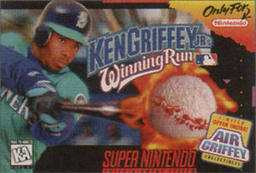A rough trip around the 35th Street Super Nintendo league this evening, as your editor was defeated summarily as the Yankees, Braves and Red Sox by the Blue Jays, Brewers and Orioles, respectively. Normally we like to not indulge in such extended fits of three-technological-generations-past passive entertainment, but today seemed worthy:
The White Sox bid farewell to Ken Griffey, Jr.
(Okay, so maybe it’s not official yet but there can’t possibly be a place for him on next year’s team and if we can’t trust Sports Illustrated’s sources, who can we trust? )
Griffey will probably find work somewhere, most likely a one-year-deal on a team that needs either veteran presence or a superstar name to sell tickets (think San Francisco, Kansas City or possibly a return to Seattle). But with all this talk of Griffey, we need to address the greatness of his namesake video game once again.
 Even all these years later, it’s amazing how ahead of its time the cartridge was. In Griffey’s game, you really can’t cherry-pick a team of superstars built on lopsided trades. You can’t stock up on lights-out flamethrowers and your arms always need rest to pitch well. Diving catches are nice, but rarely necessary if your outfielders know what to do.
Even all these years later, it’s amazing how ahead of its time the cartridge was. In Griffey’s game, you really can’t cherry-pick a team of superstars built on lopsided trades. You can’t stock up on lights-out flamethrowers and your arms always need rest to pitch well. Diving catches are nice, but rarely necessary if your outfielders know what to do.
The thing with Griffey’s game – or any like it, really – is that you can’t go into it thinking of who was good or who became good, but rather who was supposed to be good. In real life, the Cleveland Indians won the AL Central by 14.5 games, but in the world of Ken Griffey Jr.’s Winning Run they’re a bunch of nobodies capable of pretty much nothing. The 1996 Mariners were coming off a trip to the ALCS and dominate the world of Griffey’s game on the strength of Randy Johnson and #24 himself, even though the real 1996 Mariners paled in comparison to the 1996 Rangers, who in turn become terrible in the world of Griffey’s game because the 1995 Rangers went 74-70.
The Rays and Diamondback are theoretical teams you need to perform certain tricks to access, and in the world of Griffey’s 1996 game they’re also both undefeatable supersquads. Griffey’s game didn’t have the MLBPA licensing to use real names, but Kevin Brown’s doppelganger isn’t a roid-raging jerk yet. Nor is Roger Clemens’. Nor is Juan Gonzalez’.
In the world of Griffey’s game, nothing is as it actually was, even though the entire universe of Griffey’s game was perfectly scripted to be exactly as it should be. Good players were frozen on the precipice of greatness while one-year wonders go 4-for-4 day in and day out. Fictionalized Manny Ramirez is a scrawny outfielder with okay speed and power; cartoon Jim Thome is an agile third baseman and stays that way forever. Bizarro Frank Thomas never gets hurt, suspended in time and driving in at least two runs even when he hits a foul ball.
Griffey may be gone, but with luck the 2009 Sox can learn a thing or two from his 1996 game. And, you know, his 1996 playing wasn’t too shabby, either.